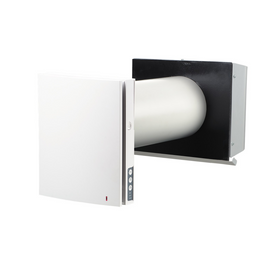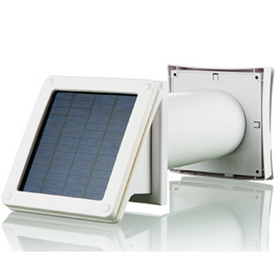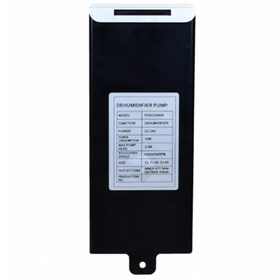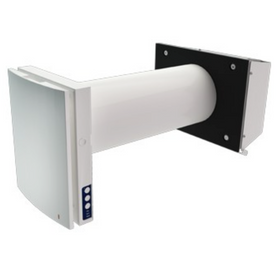
Natural Ventilation: What Is It and When Can You Use It?
Last Updated: Apr 9, 2025Many homeowners incorrectly believe that they have to choose between energy efficiency and indoor air quality when designing their homes. This line of thinking assumes that a completely airtight building envelope that improves thermal performance leads to less healthy indoor air quality. On the flip side, a "leaky" home will push up your heating and cooling bills. However, it can also allow VOCs, allergens, and other indoor air pollutants to "escape" as fresh air infiltrates your home. Though this might have been true several decades ago, mechanical ventilation systems such as ERVs or HRVs allow even the most airtight dwellings to benefit from an influx of fresh air to replace the stale air inside the walls of our home.
Though mechanical ventilation systems offer an energy-efficient strategy to improve indoor air quality for passive homes and other homes focusing on an airtight building envelope, natural ventilation strategies can also provide an opportunity to achieve the same. Below, we explain how you can incorporate natural ventilation strategies in your home. We will also look at some of the advantages and drawbacks of natural ventilation at home.
Table of Contents
- What Is Natural Ventilation?
- How Do Natural Ventilation Strategies Work?
- What Are the Benefits of Natural Ventilation Systems?
- Can You Plan for Natural Ventilation?
- What Are The "Rules" of Designing for Natural Ventilation?
- How Can You Test A Natural Ventilation System?
- When Do You Not Want Natural Ventilation?
What Is Natural Ventilation?
In the simplest of cases, simply opening up a window on a cool summer evening so that the fresh outside breeze can refresh your home is an example of natural ventilation. Even in the most airtight homes, every time you open a door or window, a bit of natural ventilation enters the house. Traditionally, almost every building was naturally ventilated through strategically placed windows and building practices that left gaps and cracks throughout the building envelope.
Today, natural ventilation strategies are purposefully designed to take advantage of natural forces such as wind and buoyancy to allow fresh air to permeate and cool a building. These strategies can help improve the home's thermal comfort during warmer months without relying on artificial cooling methods.
Unless you live next to a factory or a busy highway, the chances are that the air outside your home is actually healthier than the inside air that you are breathing. In fact, studies undertaken by the Environmental Protection Agency (EPA) find that indoor levels of air pollutants may be two to five times, and sometimes upwards of 100 times, higher than outdoor levels. Natural ventilation strategies not only eliminate unwanted odors that accumulated in your stale indoor air but also can get rid of volatile organic compounds (VOCs) and other indoor air contaminants that might compromise your health.

How Do Natural Ventilation Strategies Work?
Natural ventilation strategies mostly rely on two different natural forces to allow fresh air to permeate your home:
- winds, and
- buoyancy.
Studies have found that even slight winds with an air velocity of 160 feet per minute (fpm) can lower the interior temperature inside your home by as much as 5 degrees Fahrenheit. Buoyancy ventilation refers to the natural differences in air density between interior and exterior air. This variance in air density forces the warmer air to rise above the cold air. This natural process subsequently results in an upward air stream. According to Moffitt, a company with years of experience in installing natural ventilation systems, "the effectiveness of the buoyancy effect increases as the temperature differences between the different sections of the building increases. Increased height between the lower and higher apertures leads to better displacement and superior ventilation."
What Are the Benefits of Natural Ventilation Systems?
According to the US Department of Energy, around 75 percent of all households in the United States have at least one air conditioner in use. Collectively, air conditioners' operation during the warm summer months accounts for around 6 percent of all the electricity produced and consumed in the United States. In dollars and cents, Americans spend over $29 billion on air conditioning each year. Artificial cooling for our homes also had led to the emission of an estimated 117 million metric tons of carbon dioxide per year - increasing the scope and effect of climate change.
These statistics should convince us that reducing our dependence on artificial air conditioning is one surefire way to reduce our household carbon footprint. Natural ventilation can help lower our reliance on central air conditioners, especially when combined with other strategies like energy-efficient landscaping and smart thermostats.
Other advantages that come with incorporating natural ventilation strategies in your home include:
- Reduced energy bills: Wind and natural buoyancy are free and are a great way to cut back your summer AC bills.
- Low maintenance: A central AC unit will most likely need yearly maintenance and inspections by professional technicians. In contrast, well-designed natural ventilation strategies are essentially maintenance-free.
- Improved Air Quality: Opening up windows in the springtime is a great way to "flush out" the stale indoor air accumulated over the winter. In the same way, natural ventilation strategies allow the fresh, outdoor air to permeate your home.
- Consistency and Comfort: The best natural ventilation systems also ensure that every room of your home receives fresh, outside air. This planning helps eliminate stale air accumulation in certain areas of your home (such as basements).
- Reduced Carbon Emissions: Natural ventilation strategies can also reduce your household's carbon emissions via less mechanical cooling dependence.

Can You Plan for Natural Ventilation?
Designing a dwelling to take advantage of natural ventilation requires a thorough observation of:
- where the dominant winds come from
- the location of cooler or shaded areas around your home
- select window types that direct or avert airflow
- orient windows and doors to take advantage of natural airflow
- strategically position windows to influence cross ventilation

What Are The "Rules" of Designing for Natural Ventilation?
The best natural ventilation strategies will always be context-specific and dependent on your local climate and other natural forces. However, there are a few general rules that you can take into consideration:
- Site your home so that the ridge of the house is perpendicular to the prevailing summer winds. This orientation will capitalize on wind-induced ventilation. Check out these "Wind Rose Diagrams" provided by the NOAA to help determine your region's prevailing winds.
- Do not plant windbreak landscaping that could block summer winds.
- Create an articulated floor plan that focuses on relatively narrow building design. Wider buildings tend to have difficulties delivering fresh air to all home areas, and narrower buildings do better in this regard.
- Incorporate at least two different supply and exhaust openings in each room. Ideally, you will want to place the exhaust vents/windows higher than the inlet vent/window to maximize the buoyancy stack effect.
- Install a ridge vent. Similarly, a small vent in the attic roof's highest point will give an outlet for buoyancy and wind-induced ventilation.
- Maximize internal airflow. Good natural ventilation strategies also rely on an indoor air floor plan that encourages airflow between rooms. For example, door-less entries and transoms for private bedrooms are options to maximize interior airflow.
- Ventilate your attic. By ventilating an attic space, you can drastically limit unwanted heat transfer to the conditioned rooms below.
- Ceiling fans and whole-house fans can be designed to work in tandem with natural ventilation strategies. When correctly installed, these devices can offer up to 9 degrees Fahrenheit of effective temperature drop. To do this, they only use one-tenth of mechanical air-conditioning systems' electrical energy consumption!

How Can You Test A Natural Ventilation System?
So how exactly do you know if your natural ventilation system is working? Of course, lower energy bills, more comfortable indoor air temperatures, and a better smelling home are all empirical signs that your natural ventilation system delivers the desired results. But, it is also possible to hire an expert technician to determine the system's effectiveness and design.
Your natural ventilation system needs to exchange outdoor and indoor air effectively. Energy auditors and specialists might use a tracer gas to determine the number of air changes per hour in an interior space. This method requires that all doors, windows, and other openings are closed. They then release a safe tracer gas inside the home and measure the level of that gas. Once the windows, vents, or other elements of a natural ventilation system are again opened, the gas concentration is measured to determine the decay rate of the tracer gas. This test allows the auditor to determine the airflow rate by analyzing the speed of change in the tracer gas concentration over time.
When Do You Not Want Natural Ventilation?
It is essential to recognize that natural ventilation strategies are not always going to be as effective as mechanical ventilation or air conditioning systems. Unlike air conditioning systems, natural ventilation cannot reduce the humidity levels of the incoming air. In regions with hot and humid summers, homes with natural ventilation might suffer from excessive humidity levels, leading to mildew and mold issues. Thus, most builders recommend combining natural ventilation with mechanical ventilation and air conditioning strategies in humid climates. For example, you could open the windows at night when humidity levels or lower and rely on a mechanical ventilation system during the hotter and more humid parts of the day. Also, existing homes that do not have access to prevailing winds in the summer months are probably not good candidates for natural ventilation.
However, natural ventilation systems might completely replace mechanical ventilation and air conditioning system in optimum conditions. These homes would need to be ideally situated to take advantage of robust, regular, prevailing winds in the summer months. They would also benefit from energy-efficient landscaping strategies focused on providing cooling shade in strategic areas around the home.
Tobias Roberts
Tobias runs an agroecology farm and a natural building collective in the mountains of El Salvador. He specializes in earthen construction methods and uses permaculture design methods to integrate structures into the sustainability of the landscape.












